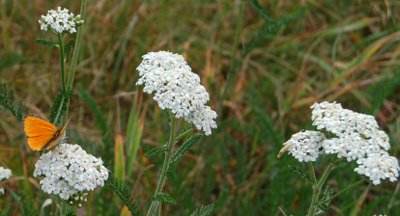
Achillea millefolium or yarrow is a flowering plant native to the Northern Hemisphere. In antiquity, yarrow was known as "herbal militaris", for its use in staunching the flow of blood from wounds. Other common names for this species include common yarrow, nosebleed plant, old man's pepper, devil's nettle, milfoil, soldier's woundwort, thousand-leaf and thousand-seal.
Yarrow has achieved its Latin name Achillea from the Greek legendary hero Achilleus, who was invulnerable except in one spot, namely his Achilles' tendon. It was said that he used the plant to heal his soldiers' wounds. Millefolium means 'a thousand leaves' and refers to the featherlike, fringed leaves.The English name yarrow comes from the Saxon (Old English) word gearwe, which is related to both the Dutch word gerw and the Old High German word garawa.
Yarrow grows up to 3500m above sea level. The plant commonly flowers from May through June, and is a frequent component in butterfly gardens. Common yarrow is frequently found in the mildly disturbed soil of grasslands and open forests. Active growth occurs in the spring. It is considered directly beneficial to other plants, improving the health of sick plants when grown near them. Several cavity-nesting birds, including the common starling, use yarrow to line their nests. Experiments conducted on the tree swallow, which does not use yarrow, suggest that adding yarrow to nests inhibits the growth of parasites.

Medicine and Food.
A garden-yarrow is used as a decorative plant , but it is the wild yarrow which was used against fever , ulcer and other inflammation-diseases. It was also used as a means against loss of hair.
In the 1700s the herb was popular in the kitchen, either raw or boiled, and the white flowers were used for relaxing baths. A balm was made from lard and crushed leaves and smeared upon rash and wounds. Henrik Smid recommended it against roundworms and stomach cramps, and Simon Paulli told about a man whose nose was cut off, but was put back with a mix of yarrow and red wine!
Yarrow was also used in traditional Native American herbal medicine. Navajo Indians considered it to be a "life medicine", chewed it for toothaches, and poured an infusion into ears for earaches. The Pawnee used the stalk for pain relief. The Chippewa used the leaves for headaches by inhaling it in a steam. They also chewed the roots and applied the saliva to their appendages as a stimulant. The Cherokee drank a tea of common yarrow to reduce fever and aid in restful sleep.
Dried yarrow is an ingrediense in teas against indigestion, and furthermore it is an excellent herb for spicing snaps, it has to draw for 2-3 days and gives a fine light green extract.In the Middle Ages, yarrow was part of a herbal mixture known as gruit used in the flavouring of beer prior to the use of hops. Fresh leaves can be chopped in butter and used in baked potatos, boiled leaves give taste to potato purees.It has now been documented that yarrow is styptic, and this effect was used in folk medicine, where the plant was recommended for stopping inside haemorrhages in stomach, gut, uterus and more, and the contracting effect of the plant was useful against haemorrhoids and varicose veins.
Today:
The plant is now used in cleaning lotions for greasy skin and in shampoos against dandruffs. The juice can soothen chapped skin and is used in face masks.
Superstition:
The plant was used in child birth to prevent the woman from giving birth to a monster. According to legend the plant grew out from the chips of Achilleus' spear, and he used the plant to stop bleedings. The dried stalks were used for prophecy by the druids.

Wild yarrow in a light pink shade
Photosensitivity:
In rare cases, yarrow can cause severe allergic skin rashes; prolonged use can increase the skin's photosensitivity. This can be triggered initially when wet skin comes into contact with cut grass and yarrow together.
Source: Anemette Olesen, Danske Klosterurter, 2001; Inge Lindt, Lægeplanter i folkemedicinen.
photo 2006/2007/2010: grethe bachmann
No comments:
Post a Comment